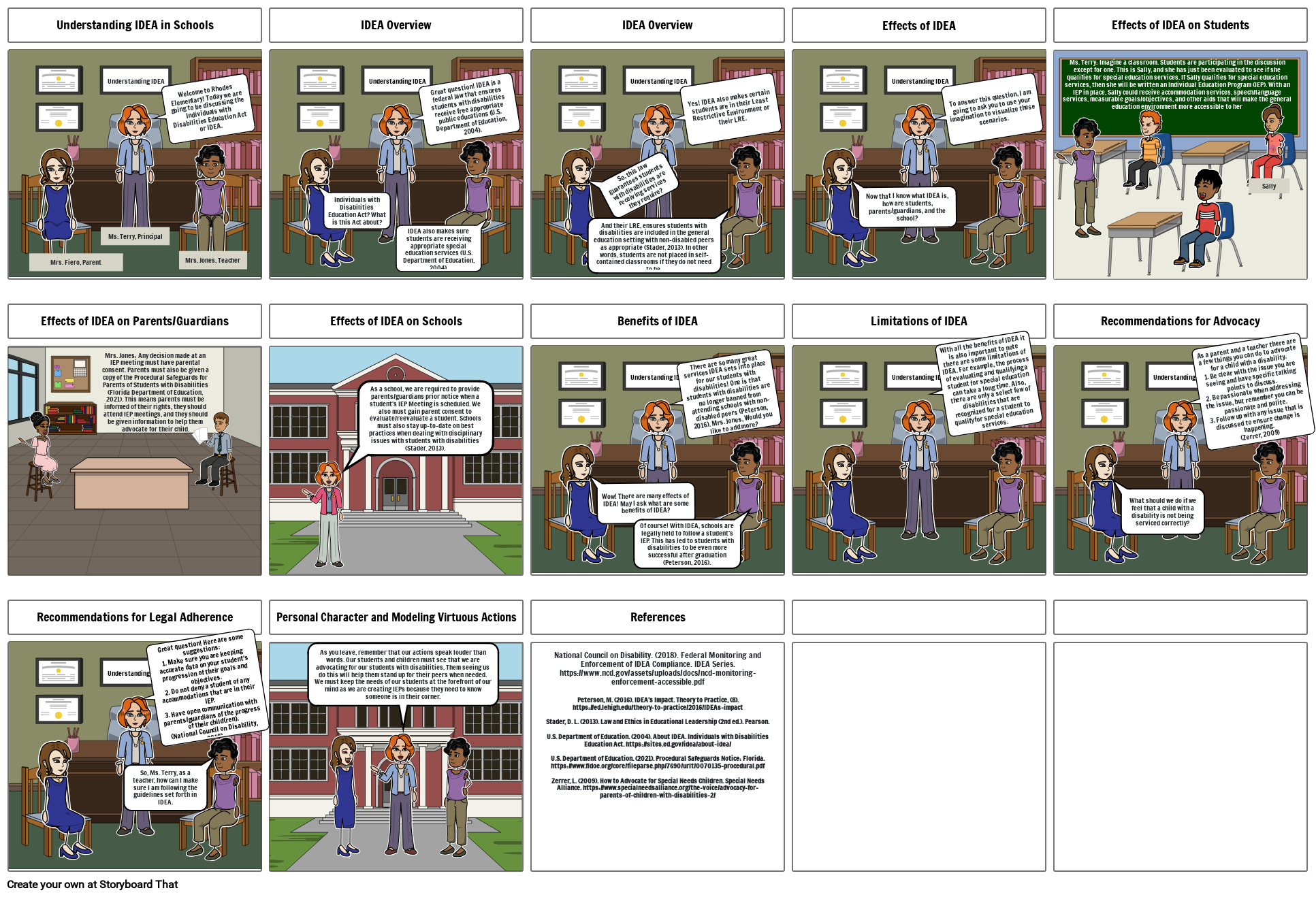Understanding IDEA

Storyboard Text
- Slide: 1
- Understanding IDEA in Schools
- Understanding IDEA
- Welcome to Rhodes Elementary! Today we are going to be discussing the Individuals with Disabilities Education Act or IDEA.
- Ms. Terry, Principal
- Slide: 2
- IDEA Overview
- Understanding IDEA
- Great question! IDEA is a federal law that ensures students with disabilities receive free appropriate public educations (U.S. Department of Education, 2004).
- Individuals with Disabilities Education Act? What is this Act about?
- IDEA also makes sure students are receiving appropriate special education services (U.S. Department of Education, 2004).
- Slide: 3
- IDEA Overview
- Understanding IDEA
- Yes! IDEA also makes certain students are in their Least Restrictive Environment or their LRE.
- So, this law guarantees students with disabilities are receiving services they require?
- And their LRE, ensures students with disabilities are included in the general education setting with non-disabled peers as appropriate (Stader, 2013). In other words, students are not placed in self-contained classrooms if they do not need to be.
- Slide: 4
- Effects of IDEA
- Understanding IDEA
- To answer this question, I am going to ask you to use your imagination to visualize these scenarios.
- Now that I know what IDEA is, how are students, parents/guardians, and the school?
- Slide: 5
- Effects of IDEA on Students
- Ms. Terry: Imagine a classroom. Students are participating in the discussion except for one. This is Sally, and she has just been evaluated to see if she qualifies for special education services. If Sally qualifies for special education services, then she will be written an Individual Education Program (IEP). With an IEP in place, Sally could receive accommodation services, speech/language services, measurable goals/objectives, and other aids that will make the general education environment more accessible to her
- Sally
- Slide: 6
- Effects of IDEA on Parents/Guardians
- Mrs. Jones, Teacher
- Mrs. Fiero, Parent
- Mrs. Jones: Any decision made at an IEP meeting must have parental consent. Parents must also be given a copy of the Procedural Safeguards for Parents of Students with Disabilities (Florida Department of Education, 2021). This means parents must be informed of their rights, they should attend IEP meetings, and they should be given information to help them advocate for their child.
- Slide: 7
- Effects of IDEA on Schools
- As a school, we are required to provide parents/guardians prior notice when a student's IEP Meeting is scheduled. We also must gain parent consent to evaluate/reevaluate a student. Schools must also stay up-to-date on best practices when dealing with disciplinary issues with students with disabilities (Stader, 2013).
- Slide: 8
- Benefits of IDEA
- Understanding IDEA
- There are so many great services IDEA sets into place for our students with disabilities! One is that students with disabilities are no longer banned from attending schools with non-disabled peers (Peterson, 2016). Mrs. Jones, Would you like to add more?
- Wow! There are many effects of IDEA! May I ask what are some benefits of IDEA?
- Of course! With IDEA, schools are legally held to follow a student's IEP. This has led to students with disabilities to be even more successful after graduation (Peterson, 2016).
- Slide: 9
- Limitations of IDEA
- With all the benefits of IDEA it is also important to note there are some limitations of IDEA. For example, the process of evaluating and qualifying a student for special education can take a long time. Also, there are only a select few of disabilities that are recognized for a student to qualify for special education services.
- Understanding IDEA
- Slide: 10
- Recommendations for Advocacy
- As a parent and a teacher there are a few things you can do to advocate for a child with a disability.1. Be clear with the issue you are seeing and have specific talking points to discuss.2. Be passionate when addressing the issue, but remember you can be passionate and polite.3. Follow up with any issue that is discussed to ensure change is happening. (Zerrer, 2009)
- Understanding IDEA
- What should we do if we feel that a child with a disability is not being serviced correctly?
- Slide: 11
- Recommendations for Legal Adherence
- Great question! Here are some suggestions:1. Make sure you are keeping accurate data on your student's progression of their goals and objectives.2. Do not deny a student of any accommodations that are in their IEP. 3. Have open communication with parents/guardians of the progress of their child(ren).(National Council on Disability, 2018).
- Understanding IDEA
- So, Ms. Terry, as a teacher, how can I make sure I am following the guidelines set forth in IDEA.
- Slide: 12
- Personal Character and Modeling Virtuous Actions
- As you leave, remember that our actions speak louder than words. Our students and children must see that we are advocating for our students with disabilities. Them seeing us do this will help them stand up for their peers when needed. We must keep the needs of our students at the forefront of our mind as we are creating IEPs because they need to know someone is in their corner.
- Slide: 13
- References
- National Council on Disability. (2018). Federal Monitoring and Enforcement of IDEA Compliance. IDEA Series. https://www.ncd.gov/assets/uploads/docs/ncd-monitoring-enforcement-accessible.pdfPeterson, M. (2016). IDEA’s Impact. Theory to Practice, (8). https://ed.lehigh.edu/theory-to-practice/2016/IDEAs-impactStader, D. L. (2013). Law and Ethics in Educational Leadership (2nd ed.). Pearson.U.S. Department of Education. (2004). About IDEA. Individuals with Disabilities Education Act. https://sites.ed.gov/idea/about-idea/U.S. Department of Education. (2021). Procedural Safeguards Notice: Florida. https://www.fldoe.org/core/fileparse.php/7690/urlt/0070135-procedural.pdfZerrer, L. (2009). How to Advocate for Special Needs Children. Special Needs Alliance. https://www.specialneedsalliance.org/the-voice/advocacy-for-parents-of-children-with-disabilities-2/
Over 30 Million Storyboards Created
No Downloads, No Credit Card, and No Login Needed to Try!
